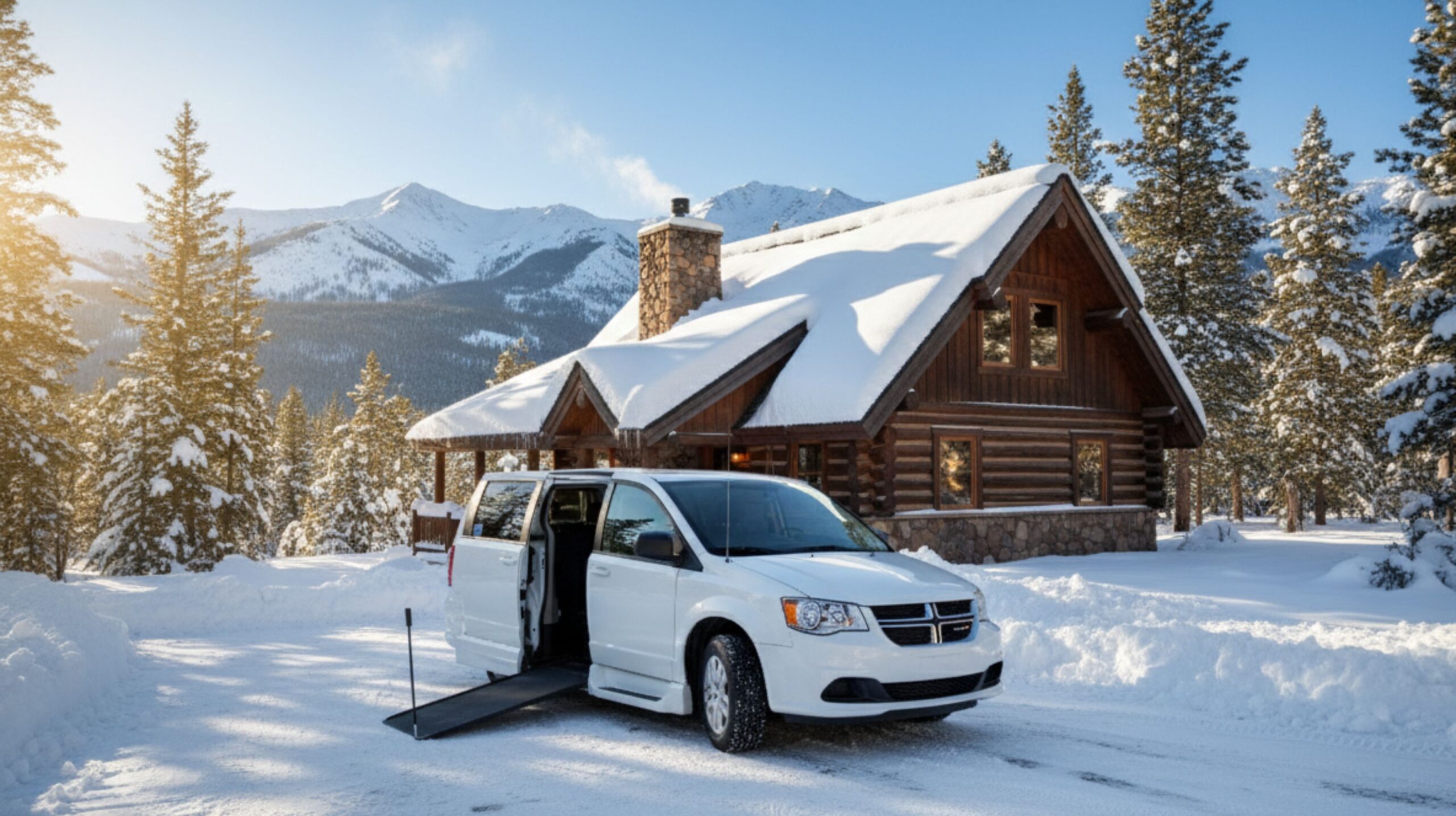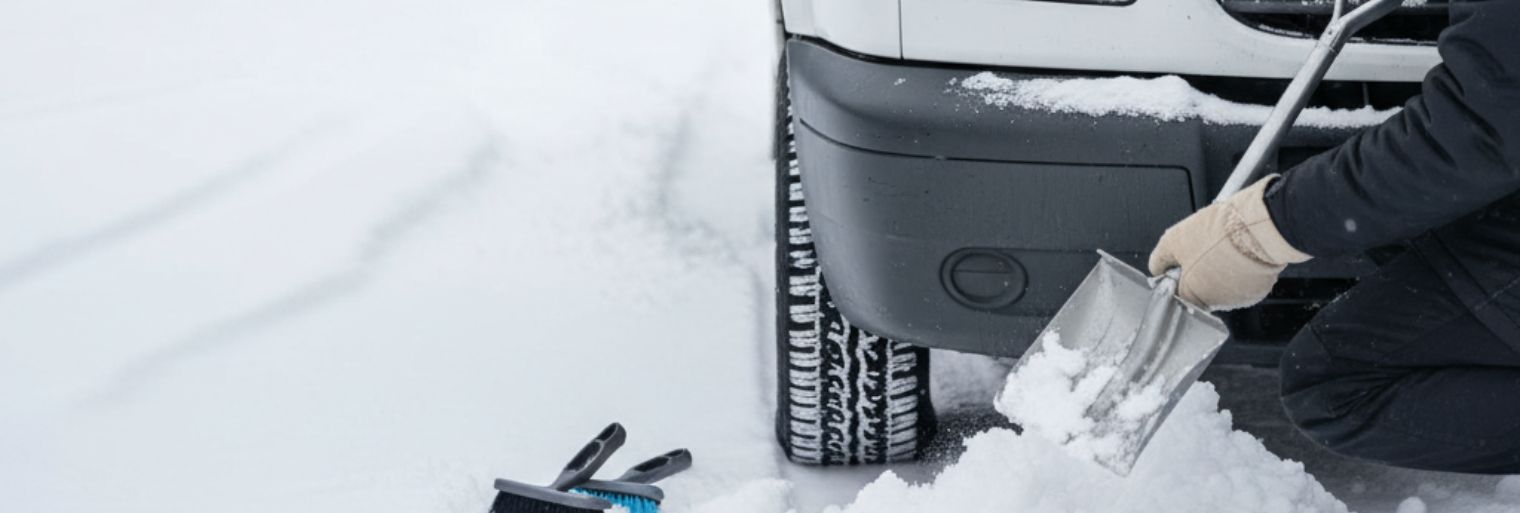
There’s nothing more magical than winter getaways when the world slows down, snowflakes dance through the streets, and cold air wakes you right up.
But for all its charm, winter travel can be unpredictable. Roads vanish under snowdrifts, parking lots glaze over, and the perfect route on the map can change overnight. When accessibility is part of the mix, every stop brings new questions: Will the ramp freeze? Will the heater hold out? What about door jams?
Thankfully, wheelchair-accessible vans come equipped with all the necessary features, making it possible to take that cross-state road trip, book a mountain cabin getaway, or simply escape the same four walls for a while.
This guide breaks down how to prepare for your snowy getaway, from choosing a winter van rental and packing cold-weather emergency gear to mapping safe routes.
Why Early Booking for Your Winter Van Rental Matters
Most people start planning winter getaways when the first snow hits, but waiting until the last minute can cost them the right van, their preferred features, and result in extra fees. Here’s why timing matters:
Beat the Rush: Limited Availability and Peak Season Demand
When booking a winter van rental, most travelers don’t realize that the holiday rush isn’t just Christmas and New Year’s. There’s a “hidden high season” that sneaks in early January when some locals hit ski towns and others visit coastal campsites.
Vans in these areas can rent out faster than you think. If you wait until the last minute, you might end up with older models missing key features. On top of that, popular winter destinations may have limited pickup locations. Delaying your booking could mean driving hours just to get your van.
Booking early not only secures the van that fits your plans but also guarantees a convenient pickup spot.
Get the Right Gear: Securing a Winter-Ready Van
Not all “wheelchair-accessible” vans perform well in snow. When booking a winter van rental, you must consider the following:
- Ramps: Frozen ramps can be a nuisance. If possible, opt for factory-installed ramps that hold up in sub-zero temps better than aftermarket ones.
- Heating systems: Don’t settle for “it has heat.” Ask if it’s engine-powered or auxiliary. Engine-powered heaters warm faster and maintain temperature better on long drives.
- Insulation: Vans with proper insulation keep both passengers and mobility equipment warm. Without it, condensation builds, floors get icy, and electronics risk damage.
- Tires and traction: Some rental companies don’t change tires for the winter season, resulting in poor traction and slippery handling on snowy or icy roads. When renting a wheelchair-accessible van, it’s crucial to confirm that snow or all-weather tires are included and ask about chains or other traction aids.
- AWD vs. 4WD: The choice between all-wheel drive (AWD) and four-wheel drive (4WD) depends on your route and driving conditions. If your plans include off-road adventures, rough terrain, or challenging winter conditions like deep snow, 4WD is the safer bet. When engaged, 4WD locks the front and rear axles together for maximum traction and control, reducing the risk of slipping, losing momentum, or getting stuck on unplowed roads.
Save Your Cash: Lock in Better Rates and Early-Bird Deals
Many rental companies quietly add winter fees for last-minute bookings, such as “peak season handling”, “snow/ice preparation”, or “resort town surcharges.” They even charge 20% to 30% extra for the same van, which can affect your overall budget.
If you book 1.5–2 months in advance, you not only secure the best rates but also take advantage of shoulder-month deals that often include free ski rack rentals, waived mileage fees, or mobility vans with upgraded accessibility features.

Plan the Ultimate Winter Getaway Itinerary
When planning your winter getaway, consider the following to make every mile worth it:
Pick Your Vibe: Snow or Sun?
First, think about what kind of winter traveler you actually are. Are you the type who gets giddy at the sight of the first snowflake? Or are you the escape artist who sees snow in the forecast and immediately starts checking flight prices to anywhere warmer?
If you’re chasing the snow, there are plenty of destinations.
- The Colorado Rockies boast endless ski towns, frosted evergreens, and scenic drives. When in Colorado, detour through Durango’s Festival of Trees & Wreaths or browse chic boutiques in Aspen.
- Yellowstone National Park offers otherworldly winter landscapes, steaming geysers poking through the snow, and a chance to spot wildlife in their snowy habitats.
- The Pacific Northwest, from Washington’s Cascades to Oregon’s snowy highlands, mixes alpine adventure with lush, frosted forests.
- If you want to meet Santa, why not visit the North Pole, Alaska? This place delivers the full fantasy with candy-cane streetlights, year-round Christmas music, and locals who fully commit to the bit.
However, if you prefer milder weather, we recommend visiting the following places:
- California’s coast offers dramatic cliffs, ocean breezes, and coastal campsites where you can enjoy van life without layers upon layers of clothing.
- For something more desert-adjacent, Big Bend National Park in Texas or Arizona’s red-rock country offers golden sunlight, open roads, and the kind of quiet you can actually hear.
- In Florida, cruise down to Orlando for its world-famous theme parks or park your van near the Gulf Coast for mild temps and beach sunsets that look straight out of a travel brochure. Even the Florida Keys stay comfortably warm, but you’ll still see winter manatees and seasoned snowbirds.
- With 70°F in December, Palm Springs offers a desert escape with plenty of outdoor activities.
Like What you're reading? Subscribe to our Newsletter and get new updates directly to your inbox
Smarter Route Mapping for Winter Trips
Since winter roads can change in an instant due to inclement weather, you must plan your route carefully before leaving. This includes:
- Check the weather early and often – Snow, ice, and sudden temperature drops can turn a 3-hour drive into a 6-hour drive. Build buffer days into your itinerary.
- Stick to main roads when possible – Highways and well-traveled routes are plowed more frequently and generally safer than backroads.
- Plan for shorter daily drives – Winter daylight is limited. Map your stops so you don’t have to navigate unfamiliar roads in the dark.
- Identify accessible pit stops – Make a note of wheelchair-friendly rest areas, gas stations, and restaurants along your route.
- Use multiple navigation tools – Combine apps like Google Maps, Waze, and local DOT websites to monitor road closures, weather alerts, and snow conditions.
- Have a backup route – Always have an alternate path in case highways close or roads become impassable.
- Share your route with someone – Let a friend or family member know your itinerary for safety and peace of mind.
Tips for a Smooth Winter Van Experience
Whether you’re planning a mountain escape or a coastal getaway, keep the following tips in mind for a smooth winter van experience.
Pack Essential Winter Gear
Packing for a winter van trip isn’t just about throwing in extra sweaters. You need base layers to wick moisture, insulating mid-layers to trap heat, and waterproof outer shells to handle snow or slush. Don’t forget a beanie, gloves, and thermal socks.
Cold-weather emergency gear is non-negotiable. This includes a shovel, sand for traction, windshield washer fluid, anti-slip mats, emergency blankets, a first-aid kit, and jumper cables. For overnight stays, bring sleeping bags rated for cold temperatures, extra wool blankets, and window insulation to trap heat.
Master Winter Driving
When the roads get icy, the old mantra “slow and steady wins the race” becomes literal. Increase your stopping distance, reduce speed, and avoid sudden turns or braking. Turn off traction control at a dead stop.
Beware of black ice, which often forms in shaded areas or on bridges. Since it’s nearly invisible, look for a glassy sheen on the asphalt and patches that seem darker than the surrounding pavement and maintain a steady pace.
Use your low beam lights during a snowstorm. When stuck in the snow, avoid spinning your wheels. Instead, gently press and release the gas to rock the van back and forth until you gain enough momentum to move forward.
Always look for level ground parking and clear snow before deploying the ramp. Keep your windshield and mirrors clear of frost and snow for extra visibility. If you’re stranded somewhere, the National Service Weather recommends staying in your car and contacting emergency services.

Hit the Winter Roads with Clock Mobility
If you’ve ever tried renting a modified vehicle in the middle of winter, you know the label doesn’t always tell the truth. Some ramps freeze halfway down, heaters barely keep up, and the “24-hour roadside assistance” never responds. That’s why Clock Mobility stands out with its winter-ready wheelchair vans.
Every model features reliable heating systems, snow-capable tires, and accessibility equipment that actually works in cold weather. You can choose side-entry for quick entrance/exit or rear-entry for easier parking and transfers.
We understand that travel plans can change with the weather, so we offer flexible rentals. Need to extend your trip because of a blizzard or road closures? No problem. Want it just for a weekend? That works too. We even offer a “Try Before You Buy” program, letting you experience van handling as a rental before making a long-term decision.
Our wheelchair-accessible vans rent out quickly once the weather turns cold. To reserve yours, contact us at (866) 380-3326 or stop by one of our Michigan locations.
OTHER ARTICLES YOU MIGHT BE INTERESTED IN
